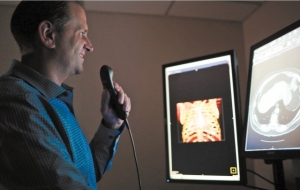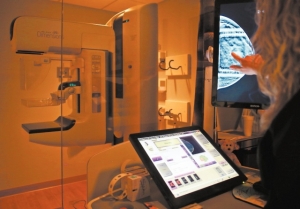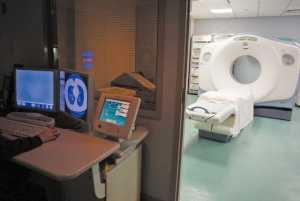Cancer edition 2017: The value of imaging
By Rochelle Moore
Published in News on October 8, 2017 4:03 PM

News-Argus/CASEY MOZINGO
Dr. Brian Munro looks at a chest scan on Monday, Sept.11 at Wayne UNC Health Care. Using the microphone he is holding, doctors can dictate what they observe for their patients records.

News-Argus/CASEY MOZINGO
Mamography supervisor Robin Benson points to an architectural distortion on a 3D breast scan at Wayne UNC Health Care on Monday, September 11.

The CT machine pictured is used to perform checks for abnormalities that can be used in diagnosis for lung and other cancers.
Two imaging tests are now offering doctors and patients some of the latest technology in identifying the early stages of cancer.
Wayne UNC Health Care and Wayne Radiologists added 3-D digital mammography testing equipment a year ago, and the hospital has more recently added a new low-dose Computed Tomography (CT) test that can detect lung cancer early.
"We do a very low-dose CT, so it doesn't have much resolution for us but we can certainly see the lungs," said Dr. Brian Munro, vice chairman of radiology at Wayne UNC Health Care.
"The lungs don't require a lot of radiation to be able to see pulmonary nodules in the lungs, and that's basically what we're looking for. Some lung cancers will present early but some don't present until they're late stage and that's why they're not treatable.
"The goal is to catch ones that present earlier."
The low-dose CT screening is available to people with a 30-pack history, meaning someone who smoked a pack of cigarettes each day for 30 years or an equal amount, such as two packs per day for 15 years. Patients need to be between the ages of 55 and 77 and have not quit smoking during the last 15 years.
"It's very helpful, I think, to people who get things caught," Munro said.
3-D MAMMOGRAPHY
The addition of 3-D mammography testing is also making a difference by helping doctors better identify abnormalities and in breast tissue and leading to fewer repeat medical visits, Munro said.
The imaging test helps identify hard-to-see areas that are not as visible with 2-D mammogram images.
"(There are) areas that are drawn in that you can't really see on the 2-D mammography," Munro said. "I think they're a lot better on the 3-D. It does increase the time we spend diagnosing, looking at mammograms, but I think it has decreased the amount of people we have to bring back, so I think that's decreased anxiety and helped women."
The newer 3-D testing captures multiple images of the breast from different angles. The technology also allows doctors the ability to scroll through images to uncover layers of tissue and helps to zero in on hard-to-detect cancers.
Robin Benson, supervisor for mammography at Wayne UNC Health Care, is impressed with the 3-D technology and how far the testing has come during her 27 years in the profession.
"I feel like this is the first step where I feel like I've made a difference because the whole time I've been in it, it's always been those two pictures of the breasts you did, whether it be in film or the computer or wherever," Benson said.
"Now, I feel like this 3-D is giving layered images, and I feel like that was a big step from where we were.
"Women are excited about it."
EYES OF MEDICINE
Today, there are a variety of imaging tests that can be performed to either detect cancer or monitor the progress of cancer treatment.
Doctors use imaging tests to take pictures of the inside of the body. The imaging tests can be used to look for cancer, determine how far cancer has spread and to see if cancer treatment is working.
Imaging tests include CT scans; Magnetic Resonance Imaging, MRI; ultrasound; X-rays and other radiographic tests; mammography; and nuclear medicine, which can include Positron Emission Tomography, better known as PET, scans.
"Once a diagnosis is made, there's a lot of imaging that comes, either to manage or to figure out how much it's spread," Munro said. "I think it's invaluable. Not to say everything relies on radiology, but I think almost all treatment plans, of any cancer treatment, rely on radiology to monitor it.
"It steers therapy every step of the way."
